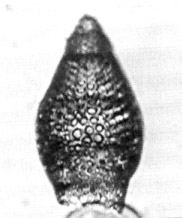 Eucyrtidium
calvertense Martin
Eucyrtidium
calvertense Martin Eucyrtidium
calvertense Martin
Eucyrtidium
calvertense MartinEucyrtidium calvertense Martin, 1904, p.450, pl.130, fig.5; Hays, 1965, p.181, pl.III, fig.6
Shell spindle-shaped, with six or seven joints, all strictures marked by internal transverse septa. Cephalis spherical to subspherical with small circular pores scattered over its surface, bearing a short conical, vertical, approximately apical spine. Thorax conical, about twice the length of cephalis, with widely, irregularly spaced circular pores of about the same size as those of the cephalis. Thickness of wall of cephalis and thorax about equal, thorax in some specimens thickened. The third, fourth, and fifth segments are of similar length, about twice that of thorax, and have a considerably thicker wall. These thicker segments have 24-30 longitudinal furrows in which lie circular pores 2 to 3 times the size of thoracic pores. Shell usually reaches its maximum breadth at the fourth segment and then tapers to a constricted mouth. Pores of last segment irregular in size and arrangement (Hays, 1965).
Total length 175-220 µm, maximum breadth 90-100 µm, length of cephalis 10-17 µm, of thorax 20-30 µm, of third segment 25-55 µm, of fourth 25-40 µm, of fifth 28-40 µm, of sixth 35-45 µm (Hays, 1965).
Similar to E. matuyamai but smaller and having a less inflated fourth segment resulting in a more streamlined outline. Longitudinal ridges are less pronounced on the abdomen and subsequent segments than on E. matuyamai. See also E. inflatum.
The above description was based on a study of Antarctic forms. Hays (1970) notes that North Pacific forms are very similar, but that the thorax is usually inflated in the North Pacific specimens while it is not in the Antarctic. Also, the longitudinal furrows are often not as pronounced on the North Pacific forms. Dimensions fall within the same range for both areas.
Detailed morphometrics (Kellogg and Hays, 1975; Kellogg, 1976) show that there is a decrease in the maximum width of the fourth segment of E. calvertense during the time that E. matuyamai became established.
Extant in the North Pacific, but became extinct in the Antarctic about 2 Ma. Found rarely in equatorial sediments. The morphotypic first appearance of E. calvertense is in the early Miocene.